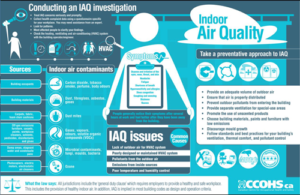Can Poor Indoor Air Quality Affect Children’s Ability to Study and Learn?
Blog
Teachers who care passionately about their classroom and students, work hard to motivate, engage, and captivate children’s attention, but sometimes what is standing in the way of success isn’t about the children or teachers, but the environment itself. Studies have shown that poor indoor quality can have farther-reaching effects than respiratory ailments and allergies; indoor pollution can also interfere with school attendance and academic performance. Read on to learn more about the impact poor indoor air quality has on studying and learning.
What is Indoor Air Pollution?
Indoor air pollution arises when the air quality in schools and homes, increases the risk of health concerns. According to the Environmental Protection Agency, “the air within homes and other buildings can be more seriously polluted than the outdoor air in even the largest and most industrialized cities.â€
Poor indoor air quality has effects both in the short and long-term. Immediate effects include irritation of the eyes, nose, and throat, dizziness, fatigue, and headaches. Long-term effects, meanwhile, can include some respiratory diseases, heart disease, and cancer.
How Does Indoor Air Pollution Affect Learning?
(click on image to enlarge) Perusing the short-term effects mentioned above makes patent that processing and retaining information can be difficult while experiencing the effects of pollution. Studies have shown that when schools improve ventilation, the number of absences are reduced, and students do best both at tests and at mental tasks.
Did you know that the number one reason kids stay at home, is asthma? Kids who are away from school repeatedly can find it hard to catch up with the rest of the class, especially in subjects such as mathematics, in which learning is cumulative.
How to Reduce Indoor Pollution in Schools and at Home
Schools should have an air quality management program in place, which involves ventilation, moisture and damp reduction, and the use of cleaning products and paints which are not harmful to health or overly strong.
VOC sensors can also be used to detect the presence of pollutants such as formaldehyde, carbon monoxide, and other compounds. Schools can purchase their own device, but it is better to rely on air quality experts, who can also provide advice on how to reduce toxin levels.
At home, there is plenty that parents can do to ensure indoor air is cleaner. Steps include cleaning with natural homemade solutions (made with ingredients such as essential oil, bicarbonate, vinegar etc. instead of toxic cleaners such as bleach), removing dust with a wet rag rather than a feather duster, using a HEPA filter to trap fine particulate matter, and avoiding the use of paraffin candles, which release toxic compounds such as toluene and benzene when burned.
Because indoor quality has such a big effect on how children feel, it can affect their ability to learn, as well as their energy and vitality. To ensure kids breathe in healthy air at all times, measure toxin levels, and take important steps to reduce any emissions caused by everything from harsh cleaning products, right through to sprays, personal care products, and paint.

